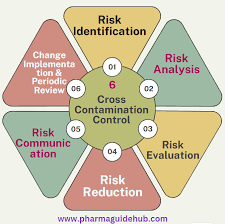Case Study: Cross-Contamination in a Multi-Product Pharmaceutical Facility

🧪 Case Study: Cross-Contamination in a Multi-Product Pharmaceutical Facility
📌 Background
A European pharmaceutical manufacturer operated a multi-product solid oral dosage plant. During a routine EMA inspection, regulatory authorities found traces of a potent API (oncology product) in an unrelated antihypertensive batch manufactured in the same facility.
⚠️ Problem
-
Analytical testing of the antihypertensive product showed unexpected peaks in HPLC chromatograms.
-
Laboratory investigations confirmed the presence of the oncology API at trace levels.
-
This indicated cross-contamination between products sharing the same manufacturing lines.
🔍 Root Cause Analysis
-
Cleaning Validation Gaps
-
Inadequate Maximum Allowable Carryover (MACO) calculations.
-
Cleaning validation limits were based on 10 ppm approach rather than toxicological assessment (PDE-based approach).
-
-
HVAC System Deficiency
-
Shared air handling system with insufficient pressure differentials.
-
Inadequate HEPA filtration and poor segregation of production areas.
-
-
Operational Practices
-
Incomplete line clearance procedures.
-
Poor documentation of equipment cleaning.
-
Inadequate staff training on cross-contamination risks.
-
🛠️ Corrective and Preventive Actions (CAPA)
-
Facility Improvements
-
Implemented dedicated HVAC systems for different product categories.
-
Introduced pressure cascade (higher pressure in cleaner areas).
-
-
Cleaning Validation Enhancement
-
Shifted from 10 ppm limits to health-based exposure limits (HBEL / PDE approach) as per EMA guideline (2014).
-
Updated cleaning SOPs and validated worst-case product scenarios.
-
-
Procedural Changes
-
Strengthened line clearance procedures with checklists and independent QA verification.
-
Introduced visual inspection and swab testing before batch release.
-
-
Training & Awareness
-
Conducted refresher training for operators on contamination control strategy (CCS).
-
Introduced periodic mock audits to test compliance.
-
-
Monitoring & Continuous Improvement
-
Routine air monitoring and swab testing included in environmental monitoring.
-
Established risk-based periodic review of cleaning validation data.
-
📈 Outcome
-
Regulatory authority lifted compliance concerns after re-inspection.
-
Company avoided product recall but faced temporary batch quarantines and market delays.
-
Internal culture shifted towards risk-based GMP with stronger emphasis on contamination control.
💡 Key Learning Points
-
Cross-contamination is a patient safety risk — even trace levels of potent compounds can cause harm.
-
Toxicology-based cleaning validation (PDE) is the global regulatory expectation (EMA, WHO, PIC/S, ISPE).
-
Contamination Control Strategy (CCS) is now required under EU GMP Annex 1 (2023) and applies beyond sterile products.
-
Integrated approach (facility design + procedural controls + training + monitoring) is essential.

